
History of North Dakota
Encyclopedia
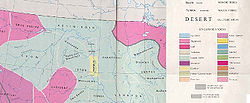
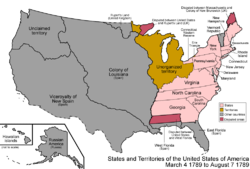
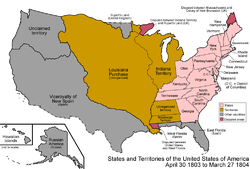
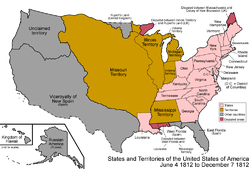
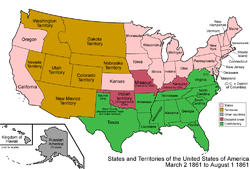
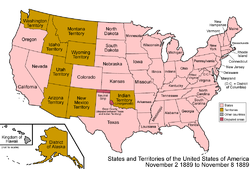
North Dakota
North Dakota is a state located in the Midwestern region of the United States of America, along the Canadian border. The state is bordered by Canada to the north, Minnesota to the east, South Dakota to the south and Montana to the west. North Dakota is the 19th-largest state by area in the U.S....
was first settled by Native Americans
Indigenous peoples of the Americas
The indigenous peoples of the Americas are the pre-Columbian inhabitants of North and South America, their descendants and other ethnic groups who are identified with those peoples. Indigenous peoples are known in Canada as Aboriginal peoples, and in the United States as Native Americans...
several thousand years ago. The first Europeans explored the area in the 18th century establishing some limited trade with the natives.
Much of the area was first organized by the United States as part of the Minnesota Territory
Minnesota Territory
The Territory of Minnesota was an organized incorporated territory of the United States that existed from March 3, 1849, until May 11, 1858, when the eastern portion of the territory was admitted to the Union as the State of Minnesota.-History:...
and then the Dakota Territory
Dakota Territory
The Territory of Dakota was an organized incorporated territory of the United States that existed from March 2, 1861, until November 2, 1889, when the final extent of the reduced territory was split and admitted to the Union as the states of North and South Dakota.The Dakota Territory consisted of...
in the 19th century. North Dakota gained statehood in 1889.
The railroads became the engine of settlement in the state. Its economy was since its early days has been heavily based on production of agricultural products such as wheat, flaxseed, and cattle, however its farming industry has declined and the state has suffered population decline in formerly heavy farming areas.
Early history
North Dakota was first settled by Native AmericansNative Americans in the United States
Native Americans in the United States are the indigenous peoples in North America within the boundaries of the present-day continental United States, parts of Alaska, and the island state of Hawaii. They are composed of numerous, distinct tribes, states, and ethnic groups, many of which survive as...
several thousand years ago. The major tribes in the area by the time of settlement were the Mandan, Hidatsa
Hidatsa
The Hidatsa are a Siouan people, a part of the Three Affiliated Tribes. The Hidatsa's autonym is Hiraacá. According to the tribal tradition, the word hiraacá derives from the word "willow"; however, the etymology is not transparent and the similarity to mirahací ‘willows’ inconclusive...
, Arikara
Arikara
Arikara are a group of Native Americans in North Dakota...
, Sioux
Sioux
The Sioux are Native American and First Nations people in North America. The term can refer to any ethnic group within the Great Sioux Nation or any of the nation's many language dialects...
, and Chippewa.
By the time European trade goods were making their way through native trade routes, the Mandan had developed a notably advanced agricultural and trading society.
La Vérendrye was the first European to explore the area. He visited the Mandan tribes around 1738 and was astounded by their level of development. Limited trade with European powers followed through the end of the century
.
The Mandan villages played a key role in the native trade networks because of their location and permanency. Their location at the northernmost reaches of the Missouri River
Missouri River
The Missouri River flows through the central United States, and is a tributary of the Mississippi River. It is the longest river in North America and drains the third largest area, though only the thirteenth largest by discharge. The Missouri's watershed encompasses most of the American Great...
placed them near the closest portages to the Hudson Bay
Hudson Bay
Hudson Bay , sometimes called Hudson's Bay, is a large body of saltwater in northeastern Canada. It drains a very large area, about , that includes parts of Ontario, Quebec, Saskatchewan, Alberta, most of Manitoba, southeastern Nunavut, as well as parts of North Dakota, South Dakota, Minnesota,...
basin and thus the fastest access to French and British traders. Additionally, valuable Knife River
Knife River
This article is about the river in North Dakota. For other meanings, see Knife River The Knife River is a tributary of the Missouri River, approximately 120 mi long, in North Dakota in the United States....
flint
Flint
Flint is a hard, sedimentary cryptocrystalline form of the mineral quartz, categorized as a variety of chert. It occurs chiefly as nodules and masses in sedimentary rocks, such as chalks and limestones. Inside the nodule, flint is usually dark grey, black, green, white, or brown in colour, and...
was produced not far from the villages.
Settlers
In 1861, the area that is now North Dakota was incorporated into the new Dakota TerritoryDakota Territory
The Territory of Dakota was an organized incorporated territory of the United States that existed from March 2, 1861, until November 2, 1889, when the final extent of the reduced territory was split and admitted to the Union as the states of North and South Dakota.The Dakota Territory consisted of...
along with what is now South Dakota
South Dakota
South Dakota is a state located in the Midwestern region of the United States. It is named after the Lakota and Dakota Sioux American Indian tribes. Once a part of Dakota Territory, South Dakota became a state on November 2, 1889. The state has an area of and an estimated population of just over...
. On November 2, 1889, North Dakota and South Dakota
South Dakota
South Dakota is a state located in the Midwestern region of the United States. It is named after the Lakota and Dakota Sioux American Indian tribes. Once a part of Dakota Territory, South Dakota became a state on November 2, 1889. The state has an area of and an estimated population of just over...
became separate states. Eager to attract immigrants, state officials broadcast widely pamphlets and newspaper accounts celebrating the "Myth of North Dakota." This myth included: 1) the myth of the garden; 2) the "work and win" philosophy that promise to the realization of the American Dream
American Dream
The American Dream is a national ethos of the United States in which freedom includes a promise of the possibility of prosperity and success. In the definition of the American Dream by James Truslow Adams in 1931, "life should be better and richer and fuller for everyone, with opportunity for each...
of home ownership through hard work; and 3) an image of an empire in the making, settled by good and just people. The settlers came by 1910, with the largest numbers comprising German Americans, Scandinavian Americans, and Yankees; the Yankees concentrated in the towns and cities, while the others became wheat farmers.
Railroads
The success of the Northern Pacific Railroad and the Great Northern Railroad was based on the abundant crops and rapidly increasing settlement in the Red River ValleyRed River Valley
The Red River Valley is a region in central North America that is drained by the Red River of the North. It is significant in the geography of North Dakota, Minnesota, and Manitoba for its relatively fertile lands and the population centers of Fargo, Moorhead, Grand Forks, and Winnipeg...
along the Minnesota border between 1871 and 1890. The initial role of the railroads in opening this area was to commercial agriculture, the relation of James B. Power to "bonanza" farming, the tremendous immigration to this valley between 1878 and 1884, and the extensive efforts of Power and James J. Hill
James J. Hill
James Jerome Hill , was a Canadian-American railroad executive. He was the chief executive officer of a family of lines headed by the Great Northern Railway, which served a substantial area of the Upper Midwest, the northern Great Plains, and Pacific Northwest...
to promote agricultural diversification constitute an important chapter in railroad colonization history.
The railroads were the engine of settlement in the state. Major development occurred in the 1870s and 1880s. The Northern Pacific Railroad was given land grants by the federal government so that it could borrow money to build its system. The federal government kept every other section of land, and gave it away to homesteaders. At first the railroad sold much of its holdings at low prices to land speculators in order to realize quick cash profits, and also to eliminate sizable annual tax bills. By 1905 the company changed its land policies as it realize it had been a costly mistake to have sold so much land at wholesale prices. With better railroad service and improved methods of farming the Northern Pacific easily sold what had been heretofore "worthless" land directly to farmers at good prices. By 1910 the railroad's holdings in North Dakota had been greatly reduced. Meanwhile the Great Northern Railroad energetically promoted settlement along its lines in the northern part of the state. The Great Northern bought its lands from the federal government—it received no land grants—and resold them to farmers one by one. It operated agencies in Germany and Scandinavia that promoted its lands, and brought families over at low cost. The battle between James J. Hill
James J. Hill
James Jerome Hill , was a Canadian-American railroad executive. He was the chief executive officer of a family of lines headed by the Great Northern Railway, which served a substantial area of the Upper Midwest, the northern Great Plains, and Pacific Northwest...
's Great Northern Railway and Edward Pennington's 'Soo Line Railroad' to control access across northern North Dakota resulted in nearly 500 miles of new track and more than 50 new town sites in one year. Many of the town sites were never settled, and were abandoned.
Germans from Russia
Germans from Russia were the most traditional of German-speaking arrivals. They were Germans who had lived for generations throughout the Russian EmpireRussian Empire
The Russian Empire was a state that existed from 1721 until the Russian Revolution of 1917. It was the successor to the Tsardom of Russia and the predecessor of the Soviet Union...
, but especially along the Volga River
Volga River
The Volga is the largest river in Europe in terms of length, discharge, and watershed. It flows through central Russia, and is widely viewed as the national river of Russia. Out of the twenty largest cities of Russia, eleven, including the capital Moscow, are situated in the Volga's drainage...
in Russia. Their ancestors had been invited to Russia in the 1760s introduce more advanced German agriculture methods to rural Russia. They retain their religion, culture and language, but the Russian monarchy gradually eroded the relative autonomy they had been promised. Many found it necessary to emigrate to avoid conscription and preserve their culture. About 100,000 immigrated by 1900, settling primarily in North and South Dakota, Kansas and Nebraska. The south-central part of North Dakota became known as "the German-Russian triangle".
These immigrants saw themselves a downtrodden ethnic group having an entirely different experience from the German Americans who had immigrated from Germany; they settled in tight-knit communities that retained their German language and culture. They raised large families, built German-style churches, buried their dead in distinctive cemeteries using cast iron grave markers, and created choir groups that sang German church hymns. Many farmers specialized in sugar beets—still a major crop in the upper Great Plains. During World War I their identity was challenged by anti-German sentiment
Anti-German sentiment
Anti-German sentiment is defined as an opposition to or fear of Germany, its inhabitants, and the German language. Its opposite is Germanophilia.-Russia:...
. By the end of the World War II, the German language, which had always been used with English for public and official matters, was in serious decline. Today their descendants speak English and German persists mainly in singing groups. Despite the loss of their language, the ethnic group remains distinct and has left a lasting impression on the American West.
20th century
Many entrepreneurs built stores, shops, and offices along Main Street. The most handsome ones used pre-formed, sheet iron facades, especially those manufactured by the Mesker Brothers of St. Louis. These neoclassical, stylized facades added sophistication to brick or woodframe buildings throughout the state.Retail stores
In the rural areas farmers and ranchers depended on small local general stores that had a limited stock and slow turnover; they could make enough profit to stay in operation only by selling at high prices. Prices were not marked on each item; instead the customer negotiated a price. Men did most of the shopping, since the main criteria was credit rather than quality of goods. Indeed, most customers shopped on credit, paying off the bill when crops or cattle were later sold; the owner's ability to judge credit worthiness was vital to his success.In the cities consumers had much more choice, and bought their dry goods and supplies at locally owned department stores. They had a much wider selection of goods than in the country general stores, and provided tags that gave the actual selling price. In an era before credit cards, the department stores provided limited credit to selected customers; everyone else paid cash. They set up attractive displays and, after 1900, window displays as well. Their clerks—usually men before the 1940s—were experienced salesmen whose knowledge of the products appealed to the better educated middle-class housewives who did most of the shopping. The keys to success were a large variety of high-quality brand-name merchandise, high turnover, reasonable prices, and frequent special sales. The larger stores sent their buyers to Denver, Minneapolis, and Chicago once or twice a year to evaluate the newest trends in merchandising and stock up on the latest fashions. By the 1920s and 1930s, large mail-order houses such as Sears, Roebuck & Co. and Montgomery Ward provided serious competition, so the department stores relied even more on salesmanship, and close integration with the community.
Politics
From the late 19th century, North Dakota's politics was generally dominated by the Republican PartyHistory of the United States Republican Party
The United States Republican Party is the second oldest currently existing political party in the United States after its great rival, the Democratic Party. It emerged in 1854 to combat the Kansas Nebraska Act which threatened to extend slavery into the territories, and to promote more vigorous...
. The Populist movement made little headway among the ethnic farmers. A representative leader was John Miller (1853–1908). Born in New York of Scottish ancestry, he came to North Dakota during the bonanza farm period, 1878-89. A Republican, he entered politics and was elected as the state's first governor, serving two years, after which he devoted his time to farm management. The greatest victory he won as governor was the defeat of a charter for a State lottery. He returned to his bonanza farm business and organized the John Miller Land Company in 1896. Miller became president of the newly-incorporated Chaffee-Miller Milling Company in 1906. He was interested in numerous projects for civic and social improvement until his death in 1908.
Republican Senator Asle Gronna
Asle Gronna
Asle Jorgenson Gronna was an American Senator from North Dakota, and one of the six to vote against the United States declaration of war leading to the First World War. Gronna was a Republican who reflected the attitudes of his region - progressive and isolationist...
was reflected the attitudes of his region - progressive and isolationist. He blamed munition makers for the preparedness movement and World War I and was part of the "little group of willful men," so labeled by President Woodrow Wilson. In 1919 he was a staunch isolationist who opposed the League of Nations treaty because it further entangled the United States in foreign relationships and limited national decisionmaking. Gronna failed to win reelection in 1920.
Langer and the NPL
The Non-Partisan LeagueNon-Partisan League
The Nonpartisan League was a political organization founded in 1915 in the United States by former Socialist Party organizer A. C. Townley. The Nonpartisan League advocated state control of mills, grain elevators, banks and other farm-related industries in order to reduce the power of corporate...
(NPL) was a faction of the Republican Party which ran farmers as candidates in the Republican primaries. Formed in 1915 with its roots in agrarian radicalism, it was strongest in the north-central and northwestern areas of the state, where Norwegian Americans predominated. The NPL advocated state control to counter the power of the railroads, the banks and the cities. Some of its programs remain in place to this day, notably a state-owned bank and state-owned mill and elevator. Conservatives, based in the towns and cities, fought back, and Republican primaries were the scene of intense political battles.
William Langer
William Langer
William "Wild Bill" Langer was a prominent US politician from North Dakota. Langer is one of the most colorful characters in North Dakota history, most famously bouncing back from a scandal that forced him out of the governor's office and into prison. He served as the 17th and 21st Governor of...
(1886–1959) in 1916 was elected state attorney general on the NPL ticket, one of the few urban men in the farm group. Langer closed brothels in Minot, became a federal marshal to raid a Minnesota brewery, and enforced school attendance laws. He turned the NPL into a political machine. Elected governor at the nadir of the Great Depression
Great Depression in the United States
The Great Depression began with the Wall Street Crash of October, 1929 and rapidly spread worldwide. The market crash marked the beginning of a decade of high unemployment, poverty, low profits, deflation, plunging farm incomes, and lost opportunities for economic growth and personal advancement...
in 1932, Langer declared a debt moratorium, stopped foreclosures, and raised the price of wheat. He also solicited 5% of each state employee's salary for an NPL newspaper, which led to federal conspiracy charges, an initial criminal conviction, and his removal from office in 1934. He was later acquitted and was reelected governor in 1936. Langer moved to the US Senate in 1940, where he served until 1959. Despite his overt political opportunism and rumors about his taking bribes, Langer's interventions during the depression overshadowed any charges of corruption in the minds of voters.
Isolationism
In the 1940s and 1950s, the state's Congressional delegation comprised Senators William Langer and Milton R. Young and Representatives William Lemke and Usher Lloyd Burdick. In in foreign policy they formed an isolationist bloc that opposed American involvement in the Cold WarCold War
The Cold War was the continuing state from roughly 1946 to 1991 of political conflict, military tension, proxy wars, and economic competition between the Communist World—primarily the Soviet Union and its satellite states and allies—and the powers of the Western world, primarily the United States...
, and opposed the UN, the Truman Doctrine, Marshall Plan, North Atlantic Treaty Organization, the Korean War, the Southeast Asian Treaty Organization, the Formosa Resolution, and the Eisenhower Doctrine of 1957. They reflected the isolationist spirit that dominated the German American
German American
German Americans are citizens of the United States of German ancestry and comprise about 51 million people, or 17% of the U.S. population, the country's largest self-reported ancestral group...
element in the state, and was likewise strong among Scandinavian Americans. Burdick's isolationism reflected his deep fears of communism and world government and, in turn, the threat they could pose to the sovereignty of the United States. Many of his constituents saw global entanglements, particularly war, as obvious dangers to the state's agricultural economy and lifestyle. His sharpest criticisms came in the wake of the outbreak of war in Korea. Burdick is remembered best for his independent voting behavior, his advocacy for the downtrodden, and his leadership in building a rhetoric of opposition to the UN in the United States.
NPL merges with Democratic Party
By the 1950s, the NPL had developed into just another part of the political establishment in North Dakota. A group of young insurgents in 1956 merged the NPL into the Democratic party. While the governorship of the state has been held approximately the same amount of time by both parties since the Democratic-NPL party was formed in 1956, the state legislature has been dominated by Republicans. Both of North Dakota's U.S. senators (Kent ConradKent Conrad
Kent Conrad is the senior United States Senator from North Dakota. He is a member of the North Dakota Democratic-NPL Party, the North Dakota affiliate of the Democratic Party...
and Byron Dorgan
Byron Dorgan
Byron Leslie Dorgan is a former United States Senator from North Dakota and is now a senior policy advisor for a Washington, DC law firm. He is a member of the North Dakota Democratic-NPL Party, the North Dakota affiliate of the Democratic Party. In the Senate, he was Chairman of the Democratic...
) are members of the Democratic-NPL party as is North Dakota's sole U.S. representative, Earl Pomeroy
Earl Pomeroy
Earl Pomeroy is a lobbyist and former U.S. Representative for , serving from 1993 until 2011. He is a member of the North Dakota Democratic-NPL Party.- Early life, education and career :...
.
Farming
North Dakota has long been the most agricultural state in the Union. Farms have increased in acreage and decreased in number. Tenancy is diminishing as technological advances are made, and more fertilizer is being used. Cash grains are being replaced by feed grains and roughage, and because of the soilbank and wheat acreage allotments, over 30 percent of the crop land is not harvested. The farm standard of living is high as the farm population decreases. Schools and churches are reduced in number by consolidation and merger.21st century
At the beginning of the 21st century, North Dakota is experiencing demographic and economic decline. The population of the state is aging, both from a rise in life expectancy, and an exodus of younger people, particularly families. Farmers no longer retire and move to town in their 50s, but keep going, while buying up neighboring farms and enlarging their holdings, so that the children are forced to move to towns and cities. However, there has been a small but steady influx into the state.The profile of the newcomers shows that compared to long-term residents, they generally are younger (60% were between 21 and 40 years old) and better educated (45% were college graduates and another 35% reported some college or postsecondary vocational-technical school experience). The migrants were motivated more by quality of life values than economic incentives; reasons for moving most often cited were desire for a safer place to live (58%), desire to be closer to relatives (54%), lower cost of living (48%), and quality of the natural environment (47%). These residents represent a very productive cohort of people who were needed to augment population strata that were severely depleted by the out-migration of the 1980s.
Themes in North Dakota History
In his History of North DakotaHistory of North Dakota (book)
The History of North Dakota is a book written by Elwyn B. Robinson covering the history of the U.S. state of North Dakota. The book's coverage spans from several thousand years ago at the time when Native Americans first settled the area that would become present-day North Dakota up through the...
, historian Elwyn B. Robinson identified themes in North Dakota history:
-
- Dependence
- Radicalism
- Economic disadvantage
- The "too-much mistake"
- Adjustment
Robinson's history is to date the only comprehensive history of the state, but his analysis has drawn fire. His assertion of a "too-much mistake" in particular, is controversial. By this Robinson meant that North Dakota had too many farms, railroad miles, roads, towns, banks, schools, government institutions, churches, and people for suitable living in a subhumid grassland. Either the state will revert to a natural grassland, have a future similar to its past, or come to grips with the "too-much-mistake" and rationally control government and the advantages of new technology. Some politicians, including Joe Satrom
Joe Satrom
Joe Satrom is a businessman and environmental lobbyist from the U.S. state of North Dakota. He won the 2004 Democratic-NPL nomination for Governor, but was defeated by the Republican incumbent, John Hoeven....
, blame the book for (un)inspiring a generation of leaders to lower their expectations for the state's future.
The land has been a central theme in North Dakota literature. In fiction, poetry, autobiography, drama, history, travel publications and websites, the same themes appear over and over regarding the land: its beauty, unforgivingness, solace, starkness, sameness, and the hard work it requires to survive and thrive. Many of the state's writers focus on the relationship of the people and the land. The landscape has barely changed since first impressions were recorded, and the relationship between people and land has likewise changed little.
See also
- History of the Midwestern United States
- Territorial evolution of North Dakota
Primary sources
- Benson, Bjorn; Hampsten, Elizabeth; and Sweney, Kathryn, eds. Day In, Day Out: Women's Lives in North Dakota. (1988). 326 pp.
- Johan BojerJohan BojerJohan Bojer was a popular Norwegian novelist and dramatist. He principally wrote about the lives of the poor farmers and fishermen, both in his native Norway and among the Norwegian immigrants in the United States.-Biography:...
, The Emigrants (1925) ISBN 0-8032-6051-2 - Maximilian, Prince of Wied. Travels in the Interior of North America in the rears 1832 to 1834 (Vols. XXII-XXIV of "Early Western Travels, 1748-1846," ed. by Reuben Gold Thwaites; 1905–1906). Maximilian spent the winter of 1833-1834 at Fort Clark.
- Meek, Martha, and Jay Meek, eds. Prairie Volcano: An Anthology of North Dakota Writing. (1995), short works by 50 recent authors
- Raaen, Aagot. Grass of the Earth (1950) true, highly revealing story of one Norwegian family in 1880s
- University of North Dakota, Bureau of Governmental Affairs, ed., A Compilation of North Dakota Political Party Platforms, 1884-1978. (1979). 388 pp.
- Wishart, David J. ed. Encyclopedia of the Great Plains, University of Nebraska Press, 2004, ISBN 0-8032-4787-7. complete text online; 900 pages of scholarly articles
- Woiwode, Larry. Beyond the Bedroom Wall: A Family Album (1975) novel about growing up in N.D.
- WPA. North Dakota: A Guide to the Northern Prairie State (2nd ed. 1950), the classic guide online edition
- Young, Carrie. Prairie Cooks: Glorified Rice, Three-Day Buns, and Other Reminiscences. (1993). 136 pp.

